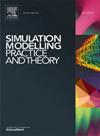New insights on the downward evacuation speed on long-distance stairs by experiment and modelling
IF 3.5
2区 计算机科学
Q2 COMPUTER SCIENCE, INTERDISCIPLINARY APPLICATIONS
引用次数: 0
Abstract
Current evacuation models for super high-rise buildings typically assume a fixed speed or a decrease in speed with distance traveled, which overlooks the combined effects of physical exertion, recovery after rest, and partnering behavior. In this study, we present new insights on the downward evacuation speed on long-distance stairs by experiment and modelling. First, long-distance down stairs experiments are carried out, in which the goal distance, rest, and partnering or not are used as control factors. Second, a speed formula that indicates how the speed decreases as accumulated distance and how much does the speed increase after the rest is defined according to the experimental results. Furthermore, an evacuation model with dynamic speed (Evac-DS model) for super high-rise buildings is built, in which the pedestrian's speed is determined by the factors considered in the defined formula, such as expected evacuation distance, evacuation time, rest time, goal distance, and partnering or not. The results show that whether in scenarios where pedestrians move alone or in pairs, the trend of speed changes in the evacuation process on long-distance stairs predicted by the Evac-DS model closely matches the experiment. Finally, the Evac-DS model is used to simulate the evacuation process in Shanghai Tower with 580m height, and the predicted speed is compared with the evacuation drill data, as well as two other models: one assuming a constant speed and another where speed decreases linearly with distance. The results indicate that the Evac-DS model can effectively predict the evacuation time and the variation of pedestrian's evacuation speed in actual super high-rise buildings. This study may be a key step in understanding the nonlinear changes in speed during long-distance stairs evacuation, and provide scientific reference and support for both theoretical research and model applications related to pedestrian evacuation in the stairwells of super high-rise buildings.
求助全文
约1分钟内获得全文
求助全文
来源期刊

Simulation Modelling Practice and Theory
工程技术-计算机:跨学科应用
CiteScore
9.80
自引率
4.80%
发文量
142
审稿时长
21 days
期刊介绍:
The journal Simulation Modelling Practice and Theory provides a forum for original, high-quality papers dealing with any aspect of systems simulation and modelling.
The journal aims at being a reference and a powerful tool to all those professionally active and/or interested in the methods and applications of simulation. Submitted papers will be peer reviewed and must significantly contribute to modelling and simulation in general or use modelling and simulation in application areas.
Paper submission is solicited on:
• theoretical aspects of modelling and simulation including formal modelling, model-checking, random number generators, sensitivity analysis, variance reduction techniques, experimental design, meta-modelling, methods and algorithms for validation and verification, selection and comparison procedures etc.;
• methodology and application of modelling and simulation in any area, including computer systems, networks, real-time and embedded systems, mobile and intelligent agents, manufacturing and transportation systems, management, engineering, biomedical engineering, economics, ecology and environment, education, transaction handling, etc.;
• simulation languages and environments including those, specific to distributed computing, grid computing, high performance computers or computer networks, etc.;
• distributed and real-time simulation, simulation interoperability;
• tools for high performance computing simulation, including dedicated architectures and parallel computing.
 求助内容:
求助内容: 应助结果提醒方式:
应助结果提醒方式:


